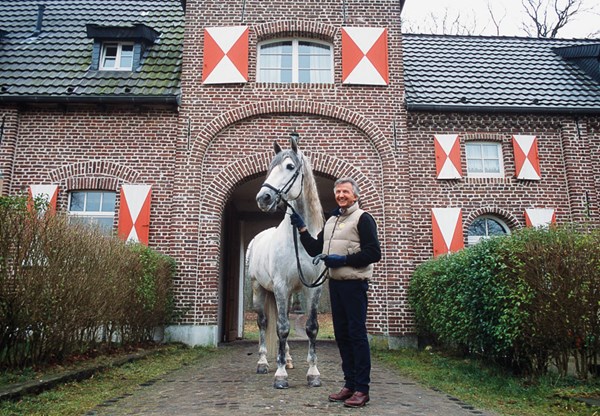One of the most common things I’ve noticed in the last few years of traveling and working with our country’s youth is an overfocus on the actual test movements. The core of the training that I do and emphasize with both my horses and my students is the understanding of how each and every movement and exercise we ride is based on improving the quality of the gaits.

Often I stop and ask my riders what it is we are trying to accomplish with the work we are doing in the dressage arena. I hear many different answers. At the core of it, all the dressage work we do can be summarized into creating a horse with better movement and gaits than when we started. The horses learn greater degrees of collection, and we help them find better ways of balancing their bodies.
We want to create more supple, agile and flexible horses. And through all that training, we create horses with better-quality gaits. One of my favorite expressions is “Training to improve your horse’s scores isn’t always correct, but correct training will always improve your scores.”
Developing Gait Quality
Each movement in the dressage arena has a certain ability to affect the horse’s gait for the better. But if it is applied wrongly, it can create the exact opposite and work to the detriment of the gait. Within our day-to-day work, if there is no benefit to the gait, that means there was no benefit to the work we did. It is important to me for each and every rider I work with to understand how each movement or exercise is affecting the gaits and then to make sure we are working with each horse as an individual to improve his overall way of going.
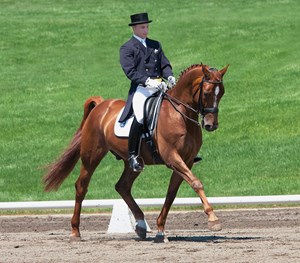
If we look at the movements as bringing horses into greater degrees of collection, making them more supple and helping to create greater mobility through the forehand, we create better-quality gaits. To achieve this, we have to look at each gait and understand its basic quality:
1. The walk marches.
2. The trot swings.
3. The canter jumps.
Our work should create more jumping expressive canters, more cadenced and ground-covering trots and more four-beat, marching and ground-covering walks. This understanding is important to me in my day-to-day teaching and training. It is especially important for youth riders in the country whom I view as our next generation of both Olympic team members and also trainers. It is one of my passions that in teaching amateurs, professionals and youth riders alike, I am creating thinking riders who understand the how’s and why’s we ride each movement and how each of those movements affects the horses. Through the discussion of some sample movements, it is my hope that I can pass on how the mechanics can affect the quality of the gaits and, in turn, why this is essential for a thinking rider to understand.
Developing Flexibility
Longitudinal (back-to-front) and lateral (left and right) flexibility are key to understanding how the movements affect the gaits. Both aspects of that flexibility are what help increase the horse’s range of motion. All the work we do with him should be challenging the range of motion that works both on the lateral plane of the horse’s body as well as the longitudinal plane.
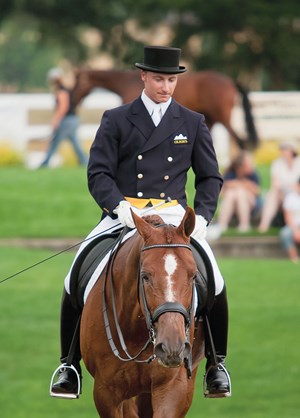
When we talk about the longitudinal range of motion, we are talking about the horse’s ability to flex over his topline with regard to roundness, stretching and expansion or compression. This is where we hear and often use the term “lifting through the back,” which allows a horse to find a greater ability to bend and expand the joints and muscles with regard to collection and extension.
Take, for example, the canter: The canter is a three-beat gait with a clear moment of suspension. The back of the horse has to be round, supple and flexible in order for the hind legs to travel farther under the body to create a greater degree of collection. Without a clear moment of suspension in the canter, there is not enough time in the sequence of the stride for the horse’s hind legs to travel far enough under his body to develop the collection we need.
The jump of the canter is the basic quality of the gait, and we need to be aware of it in all the movements we ride within it. It is based on many things: natural quality of the canter, strength, elasticity in the body, etc. But one of the biggest contributing factors to the ability of the horse to become more jumping in the canter, or for us as riders to improve the jump of the canter, is the use of the horse’s back.
It is also harder to attain the collection needed in the higher levels without sustaining or creating more jump in our training. A canter half pass is not beneficial to the horse’s long-term development if, within that half pass, the quality of the canter, or the jump of the canter, dissipates as the horse is half-passing. If he loses jump, he loses the ability to keep his hind legs under, and if he loses the ability to keep his hind legs under, he loses balance, impulsion and many other things.
Longitudinal Flexibility
Overall longitudinal flexibility and strength can be increased through various movements and exercises. Think of yourself as a personal trainer taking your horse to the gym every day and running him through a core-building workout routine. Anything that asks him to flex and lift his abdominal muscles is something that is going to work his body on a longitudinal level. Any and all of our collected work should be challenging that flexibility and strength as the ability to collect lies in the ability to lift through the back.
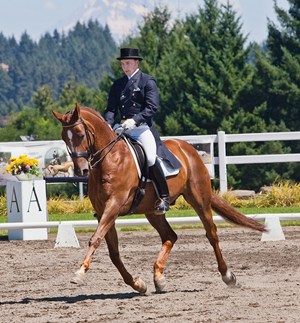
Two of my favorite, yet simple, exercises for working longitudinal strength and flexibility are trot–canter–trot and canter–walk–canter transitions.
The way a horse has to lift and use the back in those transitions cannot be recreated anywhere else in the work we do and is probably simplest and the most beneficial thing we can do to help create strength and flexibility longitudinally through his topline. My teacher used to say the trot–canter transitions, repeated quietly and daily, were the best thing you could do to put muscle on your horse’s top line.
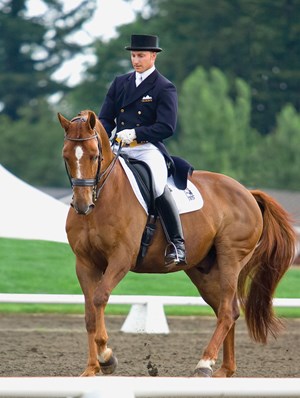
Proper stretching work and huge amounts of walking on a long rein are also prerequisites for creating longitudinal flexibility. Letting the horse’s body fully stretch, or “uncoil,” while in walk, trot and canter is extremely important in developing that range of motion, suppleness and strength that it needs to be longitudinally flexible. Compression work always needs to be complemented with expansion work. Think of your horse like an accordion that needs equal amounts of pull and push through the body to work correctly.
Lateral Flexibility
When we talk about lateral range of motion, we are talking about the horse’s ability to flex and bend through the length of his body to the left and right. All lateral work challenges that bend and flexion through the horse’s body as does any basic bending work. Lateral work gives us the chance to stretch and strengthen one side of the horse’s body at a time.
Lateral work basically isolates any weakness or stiffness in the body and allows us to work it through systematically, one section of the body at a time. The range of motion we create allows the horse to find a greater ability to bend and expand the muscles for a greater range of motion in the gait, creating more movement. If we elongate the right and left sides, we make the horse’s body longer and, in turn, able to reach farther within the stride. When the horse is correctly round, the stride will always follow the arching path of the topline. If the topline is short, the stride becomes short. If the topline arches long, the stride arches long.
Take, for example, a shoulder-in. If we ride the shoulder-in and think about the way the horse’s body needs to work in order for the shoulder-in to be developing a greater range of movement, we are on the right track. When we ride the shoulder-in to develop and challenge the range of motion, we can, for the time being, take away the worry about whether the horse is on three or four tracks or has no angle at all. What we need to think about is how the horse’s body needs to both contract on the inside and expand on the outside. So often we get weighed down by worrying if our horses are on three tracks and end up with no bend, which means no benefit to the gait.
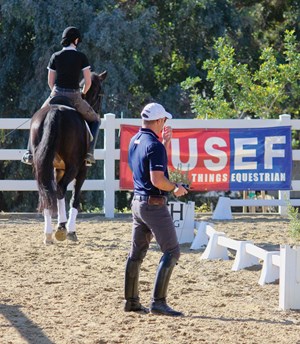
When riding into a shoulder-in, we need to really feel the rib cage of the horse displace away from our inside leg and the horse’s inside hip lower to create the depth of bend. That, in turn, stretches the horse adequately through the set of muscles on the outside of
his body. It isn’t until we feel this stretch or release through those muscles that we have the contraction on the inside. This makes room for the horse’s inside hind leg to engage under his body. As a result, the shoulder-in will create more collection.
You can really look at a shoulder-in as something that should be creating more freedom in the horse’s outside shoulder in order for that movement to be beneficial. As the horse’s outside shoulder becomes freer, his body becomes freer by stretching more. As a result, his outside shoulder gives his inside hind leg, more space since the trot is a diagonal gait. This allows for increased engagement of the inside hind leg and we should be feeling the horse’s trot grow bigger as the shoulder-in progresses.
Reiner Klimke said, “I ride a half pass to make my extensions bigger.” This makes sense because the half pass creates greater stretch and allows the horse to reach up and out in the extended paces.
Increased Range of Motion
If we take the canter pirouette, we can see how a movement can combine the lateral and longitudinal range of motion work that we need to be doing. A pirouette is the smallest circle we make, which means theoretically it needs the greatest degree of bend. We need an extremely laterally supple horse to be able to create the amount of bend needed in the end for a really good pirouette. With the bend that we looked at in the shoulder-in, we create room for the inside hind leg to tuck under the horse’s body through the displacement of the rib cage, away from the rider’s inside leg.
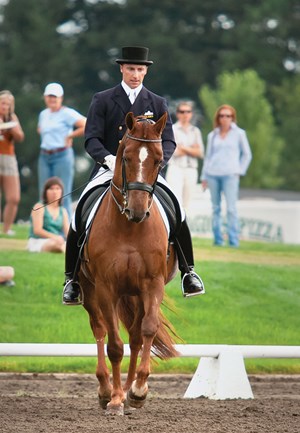
With the longitudinal aspect of the canter taken into account, we need enough jump in the canter (or lift through the back) to allow the horse room and time to bring both hind legs far under his center of gravity. In turn, he will be able to rock his weight back onto those engaged hind legs, creating the collection we need.
We need a longitudinally strong and supple horse to create this jump and collection. If we don’t have the lateral and longitudinal strength and flexibility for the movement, horses and riders find ways to compensate. The horse may end up incorrectly spinning or losing bend, rhythm, balance or tempo—all faults of a bad pirouette. When done correctly, the pirouettes should strengthen and stretch our horse’s body, which, in turn, creates a horse who can move better.
The pirouette, as is the case with any movement when done correctly, is supposed to showcase the horse’s strength, balance, flexibility and overall movement as well as train those qualities. If we ride, train or accept a movement that doesn’t do that, we are not improving our horses.
When done correctly, all movements have the ability to improve the quality of our horse’s gaits. It is up to us as thinking riders to understand how each movement and exercise works to help create that and, in turn, produce horses who move more majestically and expressively with each day of training.
This article is from the Dressage Today magazine archives.
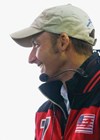
Jeremy Steinberg is the U.S. Equestrian Federation (USEF) National Dressage Youth Coach and a Fédération Equestre Internationale (FEI)-level trainer. Since earning an individual gold medal and a team silver at the 1996 North American Junior/Young Rider Championships, he has gone on to a successful competition career as a professional. His accomplishments include participation in the 2007 U.S. League Finals for the World Cup and multiple U.S. Dressage Federation regional championships at Grand Prix. He and his partner, Shauntel Bryant, operate Steinberg-Bryant Dressage out of Tall Firs Equestrian Center in Redmond, Washington (steinberg-bryantdressage.com).
Five Tips for Selecting a Trainer
I often have riders ask me if they are working with the right person or how they should go about finding an instructor if they are moving to a new place. Many of the Young Riders I work with move because of schools. Here are five tips I like to give:
1. Simple can be good. Good horsemanship and good riding are good horsemanship and good riding. Make sure you like the way the trainer deals and works with his horses and clients and that his methods are in line with the care you give your horse and the work you do or want to do under saddle.
2. The trainer’s seat. Look at the trainer in the saddle and ask yourself if you want to ride the way he rides. I’ve always worked with riders I want to emulate on horseback. Consciously or not, you will sometimes mimic what you see, which can be great or detrimental.
3. What’s the trainer’s business model? Look at the business the particular trainer is running and make sure it is geared toward the work you want to be doing or your learning style. Is it a riding school, a sales barn, a high-volume training center, a boutique-type business or some other? Does it fit what you need and will you fit into it?
4. Does the trainer ride or have someone who does the riding for him? I think it is important to know there is riding help for you if you run into difficulty. At any stage of the game, the trainer needs to be able to get on your horse or have an assistant get on if the need arises.
5. Is there a plan and does your trainer help you set goals? Your trainer should help you achieve your goals and that begins with planning. If you don’t feel like you can work with your trainer to outline and work toward your goals, you aren’t on the road to achieving them.
Steinberg’s goals as USEF Youth Coach
Since taking on the role of U.S. Equestrian Federation (USEF) National Dressage Youth Coach, I have made a great effort to be part of creating a program with opportunities for the youth riders of our country. This begins with long-term strategic planning for all of the youth riders in the program. That planning is not only going to help them outline their future goals, but also help the USEF create the programs that are needed to fulfill these goals. The more we hear from the kids, their parents and their trainers, the more we can streamline and modify what we can and should be offering them.
Like horses, each rider is an individual and might be on a different path or have different goals. Regardless, each rider who participates in the USEF Elite Youth Training Sessions or places in the top three Juniors or Young Riders at the North American Junior and Young Rider Championship (NAJYRC) or Festival of Champions is offered a long-term strategic planning packet to work from over the next few years, with me (as the USEF National Dressage Youth Coach).
In that packet we ask riders to fill out essays and basic questions that allow us to gather information about them. This helps me to assist them over the next few years so they can best meet and reach the goals they have set.
The first questions we ask them are about their individual dressage goals. Not every youth rider in the country wants to go to an Olympic Games and not everyone wants to become a professional. Some want big businesses and some think smaller. Some want to become professionals in other careers and be able to ride as amateurs.
We enlist the youth riders’ current trainers and have them participate in the goal-setting. I will be checking in with both the riders and their trainers at regularly scheduled intervals to see where we are with those goals and reformat the plan if the need arises.
The long-term goal is to create a system where we are able to better support the long-term plans of the riders. This system helps because we can see what they will need in the future or at least have a very well-calculated guess based on their long-term plans and how they work through them over the years.
The goal is to bring more and more of our Pony, Junior and Young Riders through the ranks to compete in the Brentina Cup and join our senior teams for future Pan American Games, Olympics and World Championships.








